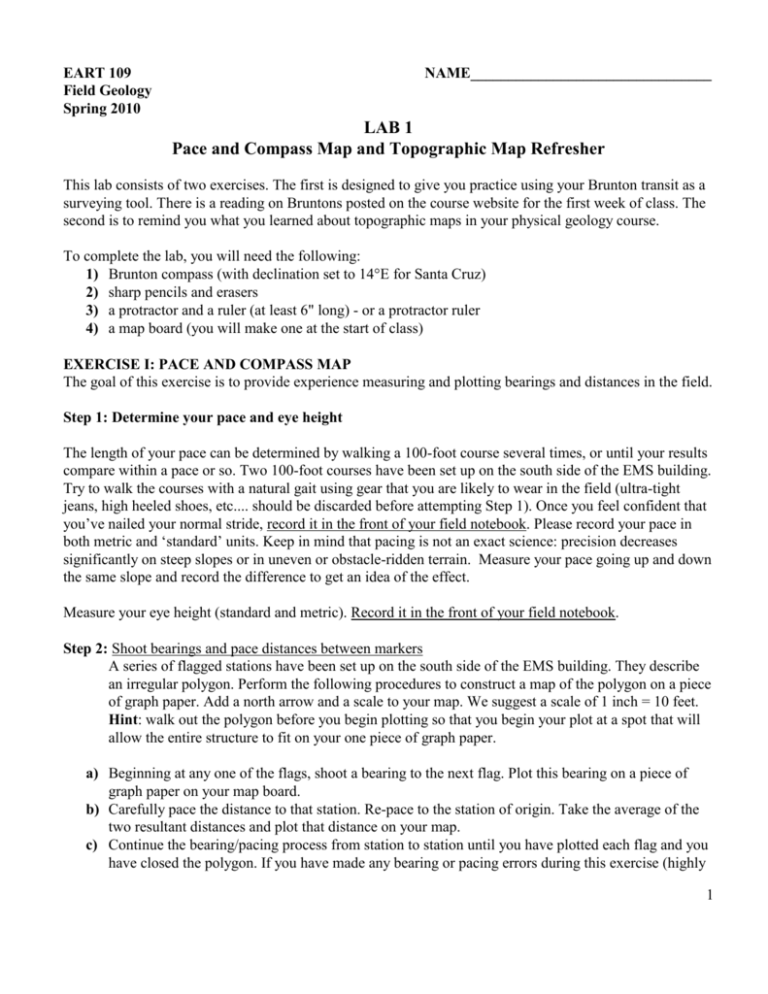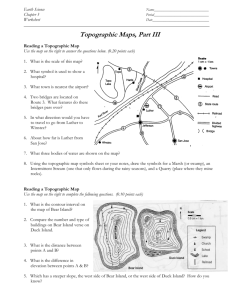2010LAB1 - Earth & Planetary Sciences
advertisement

EART 109 Field Geology Spring 2010 NAME________________________________ LAB 1 Pace and Compass Map and Topographic Map Refresher This lab consists of two exercises. The first is designed to give you practice using your Brunton transit as a surveying tool. There is a reading on Bruntons posted on the course website for the first week of class. The second is to remind you what you learned about topographic maps in your physical geology course. To complete the lab, you will need the following: 1) Brunton compass (with declination set to 14°E for Santa Cruz) 2) sharp pencils and erasers 3) a protractor and a ruler (at least 6" long) - or a protractor ruler 4) a map board (you will make one at the start of class) EXERCISE I: PACE AND COMPASS MAP The goal of this exercise is to provide experience measuring and plotting bearings and distances in the field. Step 1: Determine your pace and eye height The length of your pace can be determined by walking a 100-foot course several times, or until your results compare within a pace or so. Two 100-foot courses have been set up on the south side of the EMS building. Try to walk the courses with a natural gait using gear that you are likely to wear in the field (ultra-tight jeans, high heeled shoes, etc.... should be discarded before attempting Step 1). Once you feel confident that you’ve nailed your normal stride, record it in the front of your field notebook. Please record your pace in both metric and ‘standard’ units. Keep in mind that pacing is not an exact science: precision decreases significantly on steep slopes or in uneven or obstacle-ridden terrain. Measure your pace going up and down the same slope and record the difference to get an idea of the effect. Measure your eye height (standard and metric). Record it in the front of your field notebook. Step 2: Shoot bearings and pace distances between markers A series of flagged stations have been set up on the south side of the EMS building. They describe an irregular polygon. Perform the following procedures to construct a map of the polygon on a piece of graph paper. Add a north arrow and a scale to your map. We suggest a scale of 1 inch = 10 feet. Hint: walk out the polygon before you begin plotting so that you begin your plot at a spot that will allow the entire structure to fit on your one piece of graph paper. a) Beginning at any one of the flags, shoot a bearing to the next flag. Plot this bearing on a piece of graph paper on your map board. b) Carefully pace the distance to that station. Re-pace to the station of origin. Take the average of the two resultant distances and plot that distance on your map. c) Continue the bearing/pacing process from station to station until you have plotted each flag and you have closed the polygon. If you have made any bearing or pacing errors during this exercise (highly 1 likely) your polygon will not ‘close’ properly. Step 3: Map analysis Examine your map. How large is your closure error? What is the major source of the error - distances or bearings? Explain. Discuss what can be done to minimize the errors. Step 4: Fix your map Devise a method to substantially reduce the error on your polygon map. Use this technique to increase the accuracy of your survey. Explain on the back side of your pace and compass map how you did this! EXERCISE II: TOPOGRAPHIC MAP REFRESHER Many geologic maps are ‘built’ on topographic base maps. Topographic contour maps display information about surface elevation and geomorphology. In addition to providing a convenient base map, such information can help you locate your position, make measurements of slope, height, and distance and make intelligent guesses about rock type, orientation and structure. As a field geologist, you need to learn to ‘read’ topographic maps and develop the ability to locate your position quickly on these maps. In the following exercises you will prepare and interpret simple topographic maps and construct topographic profiles. Accurate construction of topographic profiles (today) is essential to the preparation of geologic cross sections (later in the course), so work carefully. For more information on topographic maps and geomagnetism, there is reading on the topic posted on the course website for week 1. Topographic Maps and Contours A topographic map is a graphic representation of the shape of a part of Earth’s surface. The third dimension is shown primarily through the use of contour lines. A contour is an imaginary line on the ground, along which every point is at the same elevation, or altitude, above some datum (reference plane). Mean sea level is customarily the zero contour datum. Contours are drawn at regular intervals of elevation. The vertical distance between one contour and the next is called the contour interval (typically abbreviated CI). The interval that is selected depends on the steepness of the terrain in the mapped area, the map scale and the map’s purpose. For example, in flat terrain, say the coastal plain of Texas, a five- or ten-foot contour interval would be appropriate, but in the eastern Sierra Nevada Mountains 40- to 100-foot contours work much better. To keep maps readable, only the thicker-drawn index contours are labeled with elevation values on most topographic maps. INTERPRETING TOPOGRAPHIC MAPS: TRICKS OF THE TRADE 1. Contour lines Think of contours as potential shorelines, since as lines of equal elevation, they will determine shoreline position if the region in question was flooded. 2. Spacing of contour lines Regardless of a map’s contour interval or scale, the more closely spaced the contour lines the steeper the slope. Conversely, the wider the spacing the gentler the slope. 3. Rule of V’s Where contours cross stream channels they always “V” in the upstream direction. An oft-neglected corollary is: where contours cross inclined ridges they always “V” in the down-ridge direction. 2 4. Linear features Most topographic/geomorphic features are irregular in outline and slope. Linear features are anomalous, and generally denote steepness/break in slope. 5. Parallelism (topographic grain) Some regions exhibit a definite topographic ‘grain’ due to repeated patterns of more or less parallel elements. A region of sinkholes such as the Great Meadow on the lower UCSC campus, for instance, is expressed topographically as a cluster of closed contours. Inclined strata with differing resistance to weathering and erosion will also display parallelism. Moral: watch for topographic grain/parallelism; it often reveals information about geomorphology, geology, or structure. 6. Asymmetry and dip Topography often indicates dip direction. Always pay attention to the asymmetry of ridges and valleys, as revealed by contrasting spacing of contour lines. The differential erosion of gently and moderately dipping strata of unequal erosional resistance can produce asymmetrical features. 7. Outcrop “V” and DIP direction The intersection between a valley and the plane of a dipping bed generally produces a V-shaped geomorphic pattern that V’s in the direction of bedding dip. 8. Scale and CI You must note both the scale and contour interval of a topographic map to correctly interpret its features. Problem 1: The simple topographic map below shows an island. The contour interval is 25 feet. a. Place the correct elevation for each contour line in the gap in the line. b. How high above sea level is the top of the island? Or rather, within what limits does the height of the island fall? _______________________ This height represents the total relief of the island. c. Shade in the area of the island that would be covered if sea level rose 100 feet. What is the total relief of the island following the sea level rise? ___________________ d. Delineate the following geomorphic features on the original island using colored pencils: ridges (brown pencil lines), main drainage (blue line), ‘saddles’ (green asterixes). 3 Problem 2: The topographic map on the following page represents part of the Marmot Mountain Quadrangle (Montana). Study the map and answer the following questions. a. In what general map direction (i.e., compass direction) is Rock Creek flowing? ________________ b. What is the contour interval (CI)? ________________ The fractional scale? _________________ c. What is the elevation of the highest point shown on this map? ____________________ d. What is the maximum relief in the map region shown? ____________________ e. Trace the tops of the steepest ridges on the map with a red pencil. In what direction do the rocks underlying slopes A, B, and C dip? How do you know? f. What might the different parallelism patterns between slopes ABC vs hill D tell you about differences in underlying geology? g. What do the closed contours on this map indicate? h. This particular topographic map can be turned into a simple geologic map by adding one key contact. Draw the contact in using a green pencil and explain why you chose the location you did. 4 5 Problem 3: A topographic profile is an outline or a graph of surface elevations along any line drawn on a topographic map. That is, it’s a cross section of the Earth’s surface. If the vertical scale of the profile is the same as the horizontal scale it is called a natural scale profile (no vertical exaggeration). However, if the vertical scale is made larger than the horizontal scale (usually done to make the topographic relief more apparent for profiles with subtle topography), the profile is said to have vertical exaggeration. The figure below represents a portion of a topographic map. a. Complete the topographic profile along the line A - A’ in the scaled space below the map. b. Does the island have a flat top? ___________________ c. How might the elevation of the highest point on the island be approximated? d. Estimate the height of the highest point to the nearest foot. __________________ e. Is your profile a natural scale profile? ______________________ 40 feet feet 6 Problem 4: On the map below: Streams are indicated by Topographic depressions are indicated by hatchured contours (see above). Spot elevations (in feet) are indicated by ‘x’s labeled as Bench Marks (abbrev. BM) a. Write in the correct contour values (in the spaces provided) for each of the contour lines. b. With an arrow, indicate the direction of stream flow. c. Mark the highest point on the map with a “Z” and the lowest point with a “Q”. d. Add a stream symbol to the map to show where a tributary enters the main stream. 7 8 Problem 5: The area depicted below is only partially contoured. a. How high is the cliff at point ‘C’ in the southeastern part of the map? _________________ b. What is the magnetic declination in this area? _________________ c. EXTRA CREDIT: Assuming uniform slope (unlikely, but convenient in this exercise) and using the elevations printed on the left hand side of the map, complete contouring of the index contours. Estimate contour placement between elevation points and remember the rule of V’s! 9







